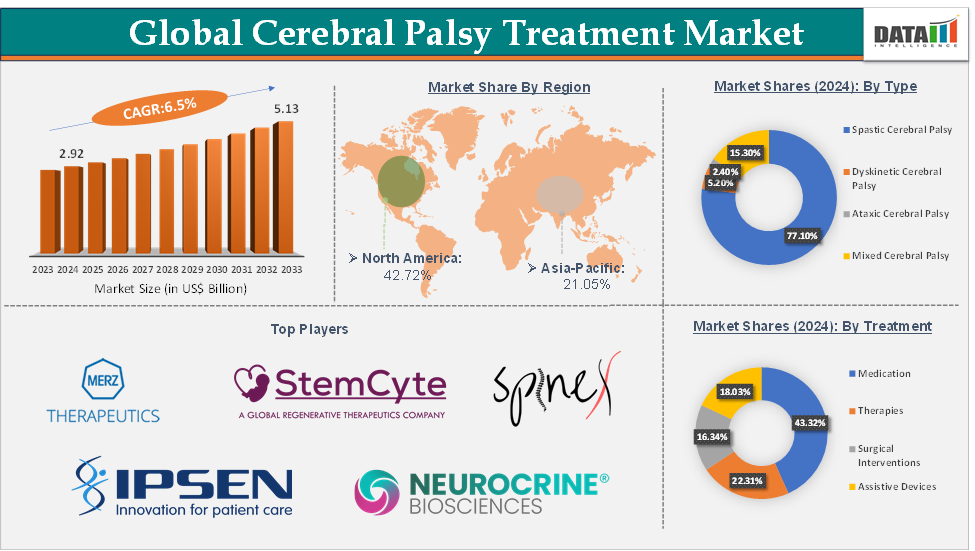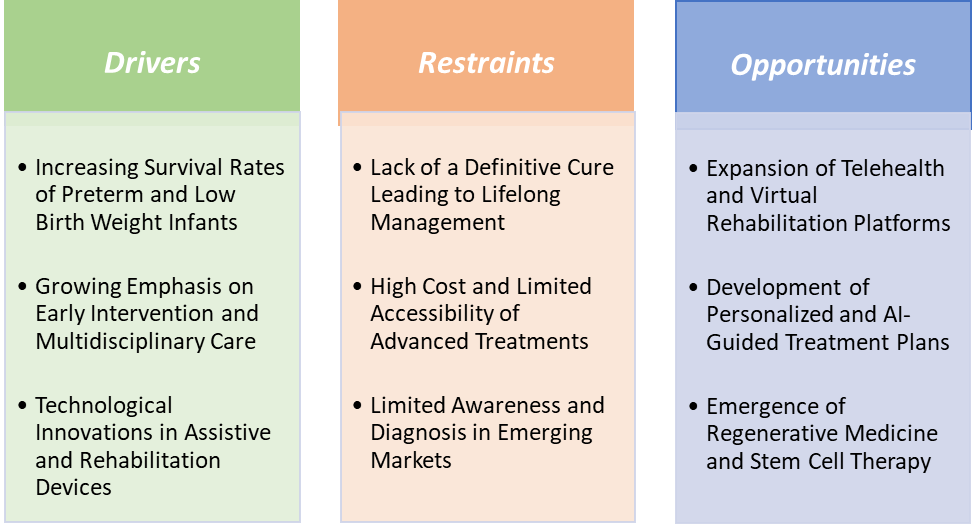Cerebral Palsy Treatment Market Size
The global cerebral palsy treatment market size reached US$ 2.92 Billion in 2024 and is expected to reach US$ 5.13 Billion by 2033, growing at a CAGR of 6.5% during the forecast period 2025-2033.
Cerebral Palsy Treatment Market Overview
The cerebral palsy treatment market is witnessing robust growth globally, driven by increasing awareness, advancements in treatment options, and rising prevalence of cerebral palsy worldwide. Cerebral palsy is a group of permanent movement disorders caused by damage to the developing brain, often diagnosed in early childhood. As no cure exists, the market focuses on symptomatic treatment to improve quality of life, including medication, therapy, surgery, and assistive devices. Moreover, increasing government and private funding for cerebral palsy research, as well as the launch of innovative therapies and devices, further fuel market expansion.
Cerebral Palsy Treatment Market Executive Summary

Cerebral Palsy Treatment Market Dynamics

Drivers:
Increasing survival rates of preterm and low birth weight infants are significantly driving the cerebral palsy treatment market growth
Advancements in neonatal intensive care and medical technology have significantly improved the survival rates of preterm infants (born before 37 weeks of gestation) and low birth weight infants (weighing less than 2,500 grams). While these improvements are a triumph for pediatric healthcare, they also contribute to a higher incidence of cerebral palsy, as preterm birth and low birth weight are major risk factors for cerebral palsy. For instance, according to the Centers for Disease Control and Prevention (CDC), there are 1 to 4 cases of CP for every 1,000 live births.
Globally, approximately 10-15% of cerebral palsy cases are attributed to complications from preterm birth. In the U.S., about 1 in 500 infants born before 28 weeks of gestation develop cerebral palsy. Improvements in survival rates of these infants have caused a relative increase in cerebral palsy prevalence, driving the demand for treatment. The rising number of children surviving preterm birth with neurological impairments fuels demand for comprehensive cerebral palsy management, spanning physical therapy, pharmacological interventions, surgical procedures, and assistive technologies.
Growing emphasis on early intervention and multidisciplinary care is also driving the cerebral palsy treatment market growth
Increasing awareness among healthcare providers, parents, and policymakers about the critical importance of early diagnosis and intervention in cerebral palsy is significantly boosting demand for comprehensive treatment solutions. Early intervention aims to improve motor function, communication, and cognitive skills, reducing long-term disability and improving quality of life. The growing clinical trials lead to earlier, more comprehensive treatment uptake, significantly propelling the growth of the cerebral palsy treatment market globally.
For instance, in January 2024, SpineX Inc. announced groundbreaking results in its first in-human study treating an adult with Cerebral Palsy (CP). The study, published in the esteemed medical journal BioElectronic Medicine, demonstrates significant functional improvements in an adult with CP after treatment with the company’s proprietary non-surgical SCiP therapy.
Similarly, in 2023, Neurocrine Biosciences, Inc. received FDA approval for valbenazine as a treatment for chorea associated with Huntington's disease. Valbenazine is in Phase 3 clinical studies as an adjunctive treatment with antipsychotics for schizophrenia and as a treatment for dyskinetic cerebral palsy.
Restraints:
Lack of a definitive cure leading to lifelong management is hampering the growth of the cerebral palsy treatment market
Cerebral palsy is a non-progressive but permanent neurological disorder with no known cure. Current treatments focus solely on symptom management and improving quality of life, rather than reversing or eliminating the condition. This fundamental limitation presents unique challenges that restrain market growth. CP patients often require continuous, multidisciplinary care throughout their lives, including physical therapy, medication, surgeries, and assistive devices. This long-term management is complex, costly, and resource-intensive.
Since treatments do not cure cerebral palsy but only mitigate symptoms like spasticity or seizures, pharmaceutical companies face lower commercial incentives to invest heavily in drug development, as patient adherence and outcomes vary widely. The lifelong treatment burden can lead to reduced adherence and challenges in sustaining long-term therapy regimens, limiting market potential for some therapies. The absence of a definitive cure for cerebral palsy, necessitating lifelong, symptom-focused management, poses a significant restraint on market growth by limiting pharmaceutical innovation, complicating patient adherence, and creating a resource-intensive care landscape.
Opportunities:
Expansion of telehealth and virtual rehabilitation platforms creates a market opportunity for the cerebral palsy treatment market
The rise of telehealth and virtual rehabilitation platforms offers a transformative opportunity for cerebral palsy treatment by addressing key barriers like limited access to specialized care, geographic constraints, and continuity of therapy. Many CP patients, especially in rural or underserved areas, face difficulty accessing regular in-person therapy due to mobility challenges or a lack of local specialists. Telehealth platforms enable remote delivery of physical, occupational, and speech therapy, expanding reach.
Virtual rehabilitation allows patients to receive ongoing therapy sessions from home, improving treatment adherence and reducing costs associated with travel and hospital visits. The use of wearable sensors, AI-driven motion tracking, and interactive therapy apps enhances real-time monitoring and personalized feedback, increasing therapy effectiveness. The expansion of telehealth and virtual rehabilitation platforms creates a major growth opportunity in the cerebral palsy treatment market by increasing access, enhancing patient adherence, and fostering innovation in digital therapeutics and remote care delivery.
For more details on this report – Request for Sample
Cerebral Palsy Treatment Market, Segment Analysis
The global cerebral palsy treatment market is segmented based on type, treatment, end-user, and region.
Spastic cerebral palsy from the type segment is expected to hold 77.01% of the market share in 2024 in the cerebral palsy treatment market
According to the Cerebral Palsy Guide, spastic cerebral palsy is the most common form, accounting for 77% of cases. Also referred to as hypertonic cerebral palsy, most individuals with this type of CP experience high muscle tone that causes exaggerated, jerky movements (spasticity). Its high prevalence and complex treatment needs make it the largest driver of the cerebral palsy treatment market.
The dominance of spastic CP ensures continuous demand for pharmacological agents, surgical interventions, and therapeutic devices specifically designed to manage spasticity. As awareness and diagnosis improve, especially in emerging markets, the spastic CP segment will remain the largest and fastest-growing within the overall CP treatment landscape.
Cerebral Palsy Treatment Market, Geographical Analysis
North America is expected to dominate the global cerebral palsy treatment market with a 42.72% share in 2024
According to the Cerebral Palsy Guide, around 764,000 people in the U.S. (including children and adults) have at least one symptom of cerebral palsy, around 10,000 babies are born each year with cerebral palsy, and between 1,200 and 1,500 school-aged children are diagnosed with cerebral palsy each year, one of the highest reported prevalence rates globally, ensuring a large patient population requiring treatment.
Rising awareness by various organizations in the region is further accelerating the market growth. For instance, United Cerebral Palsy (UCP), a leader in providing resources and assistance to individuals with disabilities, is launching its 2025 “Change is Possible for CP” grant cycle, a program designed to advance clinical and translational research that bridges the gap between science and care. Starting on January 20, 2025, researchers and clinicians across the U.S. and Canada submitted letters of intent for funding opportunities to transform the lives of children with cerebral palsy and related neurodevelopmental disabilities.
Asia-Pacific is growing at the fastest pace in the cerebral palsy treatment market, holding 21.05% of the market share
Asia Pacific’s status as the fastest-growing cerebral palsy treatment market is driven by its vast patient base, improving healthcare facilities, rising awareness, and expanding affordability, positioning the region for strong, sustained market expansion. Rising awareness campaigns and better screening programs are leading to earlier diagnosis and intervention, driving demand for therapies including physical therapy, orthotic devices, and pharmaceuticals.
For instance, the World Cerebral Palsy Day, on October 6, 2024, serves as a platform to amplify the voices of individuals living with cerebral palsy (CP). The theme, ‘#UniquelyCP’, celebrates the uniqueness of the cerebral palsy community - their interests, passions, and identities - showing that they are not solely defined by their disability. The theme emphasizes that each person is special in their own way and that society must understand and embrace these unique identities. Under the leadership of the Department of Empowerment of Persons with Disabilities (DEPwD), the Government of India marked this day with awareness campaigns across the nation. Various national institutes and regional centres under the Department hosted programmes to spread awareness about cerebral palsy and empower those affected by it.
Cerebral Palsy Treatment Market Competitive Landscape
Top companies in the cerebral palsy treatment market include Merz Therapeutics, StemCyte International, Ltd., SpineX Inc., Ipsen Biopharmaceuticals, Inc., Biomotum, Neurotech International, Neurocrine Biosciences, Inc., and Grupo Ferrer Internacional, S.A., among others.
Cerebral Palsy Treatment Market Scope
Metrics | Details | |
CAGR | 6.5% | |
Market Size Available for Years | 2022-2033 | |
Estimation Forecast Period | 2025-2033 | |
Revenue Units | Value (US$ Bn) | |
Segments Covered | Type | Spastic Cerebral Palsy, Dyskinetic Cerebral Palsy, Ataxic Cerebral Palsy, and Mixed Cerebral Palsy |
Treatment | Medication, Therapies, Surgical Interventions, and Assistive Devices | |
End-User | Hospitals, Specialty Clinics, Rehabilitation Centers, Homecare Settings, Academic & Research Institutions, and Others | |
Regions Covered | North America, Europe, Asia-Pacific, South America, and the Middle East & Africa | |
The global cerebral palsy treatment market report delivers a detailed analysis with 53 key tables, more than 54 visually impactful figures, and 146 pages of expert insights, providing a complete view of the market landscape.


